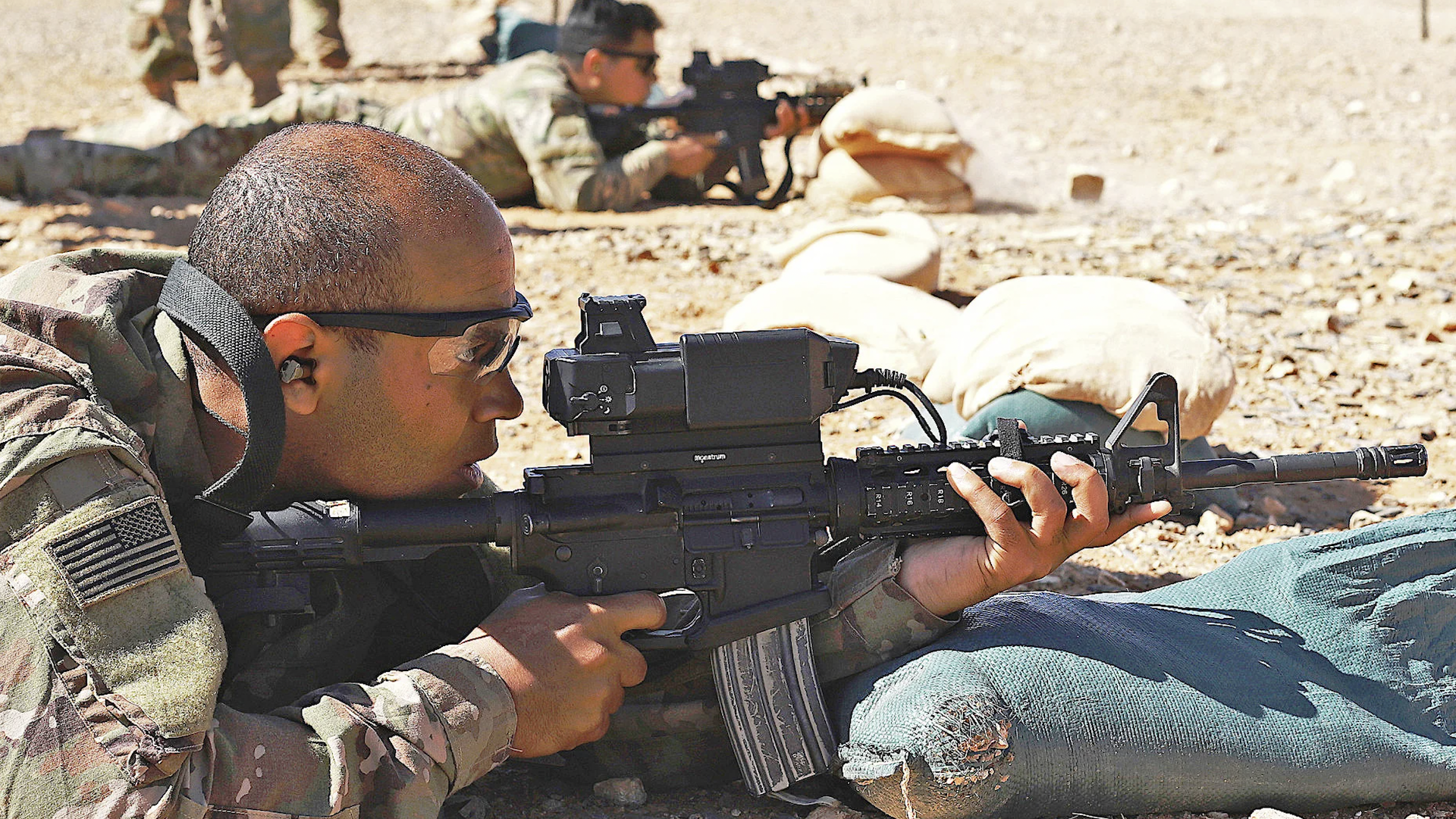

After years of testing, the Army is officially adopting a specially designed computerized fire control and optic system that will allow troops to lock on to incoming drone threats with their standard-issue rifles and disable them with a single accurate shot.
Israeli company Smart Shooter announced on Friday that it would supply its SMASH 2000L (also known as the SMASH 3000) fire control system to the Army as part of a subcontract from defense contractor Atlantic Diving Supply ahead of the Association of the U.S. Army’s annual meeting in Washington D.C. next week.

The SMASH fire control system, which has previously undergone testing by U.S. special operations forces downrange in Syria since 2019 and the Marine Corps and Navy since 2021, “allows you to acquire, lock on and engage targets … [and] the weapon to fire only when it’s a guaranteed hit,” then-CEO Devin Schweiss previously told Military.com.
The SMASH 3000 uses “target acquisition and tracking algorithms are integrated with sophisticated image-processing software” to allow the scope to easily lock onto targets at up to 200 meters away and ensure shot accuracy despite human factors like “fatigue, stress or target movement,” according to the system’s spec sheet.
In other words, the SMASH system promises a “one shot, one kill” solution for drones, making it easier for U.S. troops downrange to deal with small, fast-moving targets they encounter without expending tons of ammo.
Subscribe to Task & Purpose Today. Get the latest military news, entertainment, and gear in your inbox daily.
“Once you’ve locked on the target and you engage the fire control function, it will automatically calculate the ballistic solution to the target, but the round will not release until you have a 100% solution,” Scott Thompson, vice president and general manager of U.S. operations for Smart Shooter, previously told Task & Purpose.
Weighing just 1.63 pounds, the SMASH 3000 is a lighter version of the 2.6-pound SMASH 2000 system tested by U.S. forces in the past, compatible with both the M4 carbine and the M110 Semi-Automatic Sniper System (M110 SASS) and capable of 72 hours of activity “or up to 3,600 SMASH-assisted shots” before needing to recharge, according to the system’s spec sheet.
Smart Shooter claims that the SMASH 3000 system will be fielded to “Army divisions” as part of the service’s broader push to modernize its counter-drone capabilities. (The Army’s PEO Soldier office did not immediately respond to a request for details regarding the SMASH 3000’s adoption and fielding).

The proliferation of weaponizable commercial drones among foreign adversaries has become an acute threat to U.S. forces deployed downrange. In 2019, the amphibious assault ship USS Boxer was engaged by a pair of Iranian drones while deployed to the Strait of Hormuz, leading sailors and Marines to use a drone jammer mounted on a combat buggy on its deck to deal with the hostile systems.
The following year, the head of U.S. Central Command revealed that unidentified drones in Syria had been dropping explosives on some of the 900 U.S. troops deployed there, a development that the then-head of U.S. Central Command later called the greatest threat to U.S. troops downrange since the improvised explosive device.
“These systems are inexpensive, easy to modify and weaponize, and easy to proliferate,” then-CENTCOM chief Marine Gen. Kenneth McKenzie Jr. said in 2021. “They provide adversaries the operational ability to surveil and target U.S. and partner facilities while affording plausible deniability and a disproportionate return on the investment, all in our adversaries’ favor.”
That proliferation has led the Army to initiate a surge in its counter-drone capabilities. Indeed, the Army initially approved the SMASH system alongside several other vehicle-mounted and handheld anti-drone weapons “to address urgent and emerging operational needs of deployed forces” back in 2020.
The SMASH system is currently in operational use by the Israeli Defense Forces, Indian Navy, and “forces from NATO and Europe,” according to Smart Shooter.
“We are [honored] that the US Army continues to value our true fire control systems, and once again selects the SMASH technology for the use of its soldiers,” Michal Mor, current CEO, said in a statement. “Whether mounted on a rifle or remotely controlled, the unique SMASH technology ensures precise target elimination by guaranteeing that shot accuracy will not be affected by human errors such as fatigue and stress, nor by the target movement.”
The latest on Task & Purpose
- These are the worst pieces of military gear ever issued, according to veterans
- The Marine Corps’ new littoral combat team is changing the Marine rifle squad
- How Air Force maintainers achieved a rare perfect inspection on a 49-year-old aircraft
- Why hundreds of Camp Pendleton Marines have been stuck in sweltering hot barracks for years
- The Air Force has finally rescued a stranded Osprey aircraft from a remote Norwegian island
Want to write for Task & Purpose? Click here. Or check out the latest stories on our homepage.